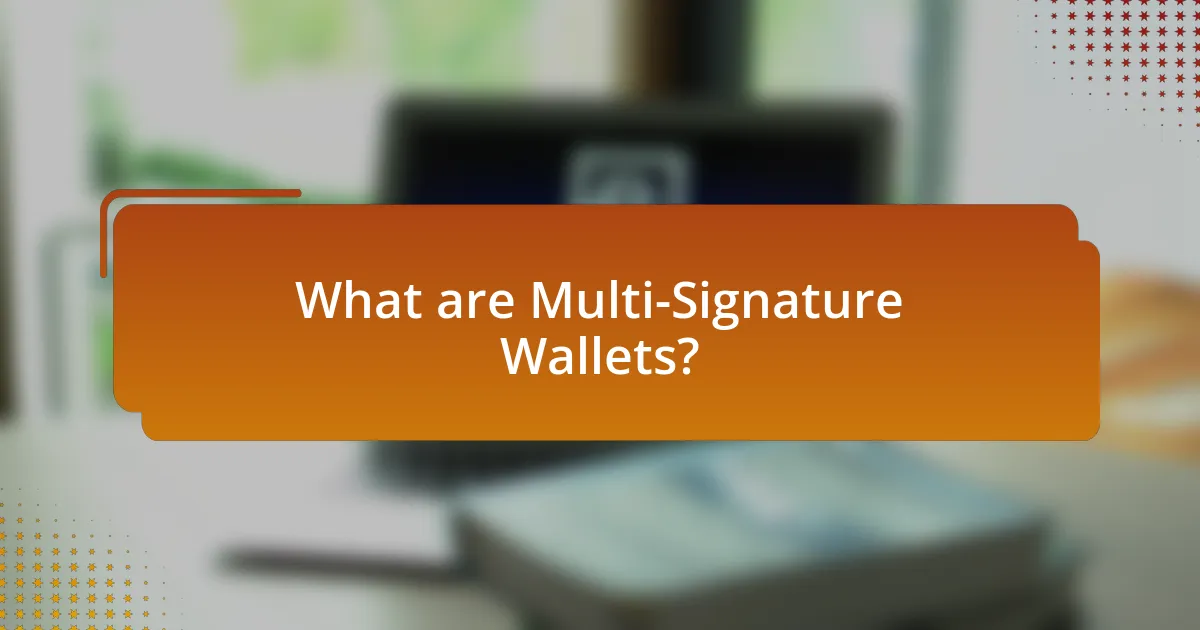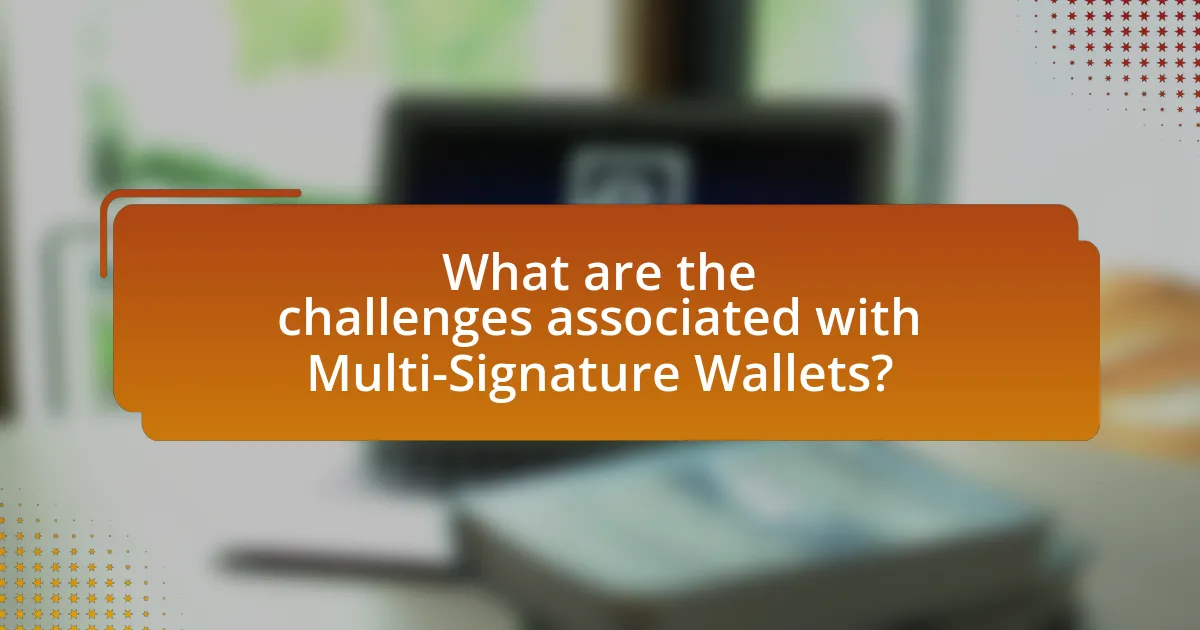Multi-signature wallets are digital wallets that enhance security by requiring multiple private keys for transaction authorization, thereby preventing unauthorized access and fraud. This article explores the functionality, key components, and advantages of multi-signature wallets, emphasizing their role in collaborative control among organizations and individuals. It also addresses the challenges and risks associated with their use, including user errors and key management issues, while providing practical tips for effective implementation. Additionally, the article discusses future trends and innovations in multi-signature wallet technology, highlighting their growing importance in decentralized finance and regulatory compliance.

What are Multi-Signature Wallets?
Multi-signature wallets are digital wallets that require multiple private keys to authorize a transaction, enhancing security through collaborative control. This type of wallet is designed to prevent unauthorized access and fraud by necessitating the approval of multiple parties before any funds can be moved. For example, a multi-signature wallet might require signatures from three out of five designated users, ensuring that no single individual can unilaterally control the funds. This mechanism is particularly useful for organizations and partnerships, where shared control over assets is essential for maintaining security and accountability.
How do Multi-Signature Wallets function?
Multi-signature wallets function by requiring multiple private keys to authorize a transaction, enhancing security through collaborative control. In this system, a predefined number of signatures, or approvals, from different key holders is necessary to complete a transaction, which mitigates the risk of unauthorized access. For example, a wallet may be set up to require three out of five signatures to execute a transaction, ensuring that no single individual has full control over the funds. This structure is particularly useful in organizational settings, where multiple stakeholders can collectively manage assets, thereby reducing the likelihood of fraud or theft.
What are the key components of a Multi-Signature Wallet?
The key components of a Multi-Signature Wallet include multiple private keys, a defined threshold for signatures, and a transaction validation process. Multiple private keys are essential as they allow several parties to control the wallet, enhancing security by requiring more than one key to authorize transactions. The defined threshold specifies how many signatures are needed to execute a transaction, which can vary based on the wallet’s configuration, such as requiring 2 out of 3 keys. The transaction validation process ensures that only transactions meeting the signature threshold are executed, thereby preventing unauthorized access and enhancing collaborative control over the wallet’s funds.
How do signatures work in a Multi-Signature Wallet?
In a Multi-Signature Wallet, signatures function by requiring multiple private keys to authorize a transaction, enhancing security through collaborative control. Each participant in the wallet holds a unique private key, and a predefined number of these signatures must be provided to validate a transaction, known as the “M-of-N” model, where M is the minimum number of signatures required from N total keys. This mechanism prevents unauthorized access, as no single key can execute a transaction independently, thereby reducing the risk of theft or fraud. For example, if a wallet is set up with five keys and requires three signatures to approve a transaction, at least three key holders must agree before any funds can be moved, ensuring a consensus-based approach to transaction approval.
What advantages do Multi-Signature Wallets provide?
Multi-signature wallets provide enhanced security by requiring multiple private keys to authorize a transaction, which reduces the risk of unauthorized access. This collaborative control mechanism ensures that even if one key is compromised, the funds remain secure as additional approvals are necessary for any transaction. Furthermore, multi-signature wallets facilitate shared control among multiple parties, making them ideal for organizations or groups that need to manage funds collectively. This structure not only mitigates the risk of single points of failure but also promotes accountability and transparency in financial transactions.
How do Multi-Signature Wallets enhance security?
Multi-signature wallets enhance security by requiring multiple private keys to authorize a transaction, thereby reducing the risk of unauthorized access. This collaborative control mechanism ensures that even if one key is compromised, the funds remain secure as additional approvals are necessary for any transaction. For instance, a common configuration might require three out of five keys to sign off on a transaction, which significantly mitigates the risk of theft or fraud compared to single-signature wallets. This multi-layered approach to authorization is particularly effective in protecting against both external attacks and internal collusion, as it necessitates consensus among multiple parties before any action can be taken.
What role do Multi-Signature Wallets play in collaborative control?
Multi-signature wallets facilitate collaborative control by requiring multiple signatures from different parties to authorize a transaction. This mechanism enhances security and accountability, as it prevents any single individual from having complete control over the funds. For instance, in a business setting, a multi-signature wallet can be configured to require approvals from several executives before funds can be moved, thereby reducing the risk of fraud or mismanagement. The use of multi-signature wallets has been widely adopted in various cryptocurrency platforms, demonstrating their effectiveness in promoting collaborative governance and safeguarding assets.
Who can benefit from using Multi-Signature Wallets?
Organizations and individuals who require enhanced security for their cryptocurrency holdings can benefit from using multi-signature wallets. These wallets require multiple private keys to authorize a transaction, which significantly reduces the risk of theft or loss. For example, businesses that manage large amounts of digital assets often implement multi-signature wallets to ensure that no single employee has full control over the funds, thereby adding a layer of accountability and security. Additionally, families or groups sharing a wallet can use multi-signature technology to prevent unauthorized access, ensuring that all parties must agree before any funds are moved.
What types of organizations typically use Multi-Signature Wallets?
Organizations that typically use Multi-Signature Wallets include cryptocurrency exchanges, investment funds, and non-profit organizations. Cryptocurrency exchanges utilize multi-signature wallets to enhance security by requiring multiple private keys for transactions, thereby reducing the risk of theft. Investment funds adopt this technology to ensure that multiple stakeholders must approve transactions, promoting accountability and security in asset management. Non-profit organizations leverage multi-signature wallets to manage donations and funds transparently, ensuring that funds are used according to the collective agreement of multiple board members or stakeholders.
How do individual users benefit from Multi-Signature Wallets?
Individual users benefit from multi-signature wallets by enhancing their security and control over their digital assets. Multi-signature wallets require multiple private keys to authorize a transaction, which significantly reduces the risk of unauthorized access and theft. For instance, if a wallet is set to require three out of five signatures for a transaction, even if one key is compromised, the assets remain secure as the attacker cannot access the funds without the additional keys. This collaborative control mechanism not only protects against single points of failure but also allows users to distribute responsibility among trusted parties, further mitigating risks associated with loss or theft of private keys.

What are the challenges associated with Multi-Signature Wallets?
Multi-signature wallets face several challenges, including complexity in setup and management, potential for loss of access, and increased transaction times. The complexity arises from the requirement for multiple private keys, which can confuse users unfamiliar with the technology. If one key is lost or inaccessible, it can result in permanent loss of funds, especially if the wallet is configured to require a majority of signatures. Additionally, the need for multiple approvals can slow down transaction processing, making it less efficient for urgent transactions. These challenges highlight the importance of user education and careful planning in the implementation of multi-signature wallets.
What are the potential risks of using Multi-Signature Wallets?
The potential risks of using multi-signature wallets include the complexity of setup, reliance on multiple parties, and the possibility of losing access. The complexity can lead to user errors during configuration, which may result in funds being locked or lost. Additionally, if one of the signers is uncooperative or loses their private key, it can hinder access to the wallet. Furthermore, if the majority of signers are compromised, the security of the wallet is at risk, as attackers could gain control over the funds. These risks highlight the importance of careful management and understanding of multi-signature wallet systems.
How can user error impact the security of Multi-Signature Wallets?
User error can significantly compromise the security of Multi-Signature Wallets by leading to unauthorized access or loss of funds. For instance, if a user mistakenly shares their private keys or recovery phrases with untrusted parties, it can allow those individuals to bypass the intended security measures of the wallet. Additionally, errors such as sending funds to incorrect addresses or failing to properly configure the wallet settings can result in irreversible loss of assets. Research indicates that human factors are a leading cause of security breaches in digital wallets, highlighting the importance of user education and awareness in mitigating these risks.
What are the implications of lost keys in Multi-Signature Wallets?
Lost keys in multi-signature wallets can lead to the permanent loss of access to the funds stored within them. In a multi-signature setup, multiple private keys are required to authorize transactions, and if one key is lost, it may prevent the wallet from being accessed or funds from being moved, depending on the specific configuration of the wallet. For example, if a wallet requires three out of five keys to authorize a transaction and one key is lost, the remaining four keys may not be sufficient to access the funds, effectively locking them away indefinitely. This highlights the critical importance of key management and backup strategies in multi-signature wallets to mitigate the risk of losing access to assets.
How can users mitigate risks when using Multi-Signature Wallets?
Users can mitigate risks when using Multi-Signature Wallets by implementing strong security practices, such as using diverse key storage methods and regularly updating their security protocols. By distributing private keys across multiple secure locations, users reduce the risk of a single point of failure. Additionally, employing hardware wallets for key storage enhances security, as these devices are less susceptible to online threats. Regularly reviewing and updating access permissions ensures that only authorized individuals can access the wallet, further minimizing risks. According to a study by the Cambridge Centre for Alternative Finance, the use of multi-signature wallets has been shown to significantly decrease the likelihood of unauthorized access and theft, reinforcing the effectiveness of these practices.
What best practices should be followed for key management?
Best practices for key management include using strong, unique passwords, implementing multi-factor authentication, regularly rotating keys, and securely storing keys in hardware wallets or secure environments. Strong passwords reduce the risk of unauthorized access, while multi-factor authentication adds an additional layer of security. Regularly rotating keys minimizes the impact of a compromised key, and using hardware wallets ensures that keys are stored offline, protecting them from online threats. According to the National Institute of Standards and Technology (NIST), following these practices significantly enhances the security of cryptographic keys and reduces vulnerabilities in key management systems.
How can users ensure proper setup of Multi-Signature Wallets?
Users can ensure proper setup of Multi-Signature Wallets by selecting a reliable wallet provider that supports multi-signature functionality and configuring the required number of signatures for transactions. This setup typically involves defining the number of private keys needed to authorize a transaction, which enhances security by requiring multiple parties to agree before funds can be accessed. For instance, a common configuration is a 2-of-3 setup, where two out of three designated signers must approve a transaction, reducing the risk of unauthorized access. Additionally, users should securely store their private keys and ensure that all signers are trustworthy, as the security of the wallet relies on the integrity of the involved parties.

What are the future trends for Multi-Signature Wallets?
Future trends for multi-signature wallets include increased adoption in decentralized finance (DeFi) and enhanced integration with regulatory compliance measures. As the DeFi sector continues to grow, multi-signature wallets will likely become essential for managing shared assets and facilitating secure transactions among multiple parties. Additionally, the push for regulatory compliance in cryptocurrency will drive the development of multi-signature solutions that meet legal standards, ensuring that these wallets can be used in institutional settings. This trend is supported by the increasing number of financial institutions exploring blockchain technology, which often emphasizes security and collaborative control as key features.
How is technology evolving in the realm of Multi-Signature Wallets?
Technology in the realm of Multi-Signature Wallets is evolving through enhanced security features, improved user interfaces, and integration with decentralized finance (DeFi) platforms. Recent advancements include the implementation of threshold signatures, which allow for more flexible access controls, and the use of smart contracts to automate transaction approvals. For instance, the introduction of EIP-1559 has improved transaction efficiency and cost management in Ethereum-based wallets. Additionally, the rise of hardware wallet compatibility with multi-signature setups has increased security by storing private keys offline, reducing the risk of hacks. These developments reflect a trend towards greater security and usability in managing digital assets collaboratively.
What innovations are being introduced to enhance Multi-Signature Wallets?
Innovations enhancing Multi-Signature Wallets include the integration of threshold signatures, which allow a predefined number of signatures to authorize a transaction without requiring all private keys. This method improves efficiency and reduces the risk of key loss. Additionally, advancements in smart contract technology enable automated execution of multi-signature agreements, increasing security and reducing human error. Furthermore, the implementation of hardware security modules (HSMs) provides a secure environment for key management, ensuring that private keys are stored safely and accessed only under specific conditions. These innovations collectively strengthen the security and usability of Multi-Signature Wallets in collaborative control scenarios.
How might regulatory changes affect Multi-Signature Wallets?
Regulatory changes may impose stricter compliance requirements on multi-signature wallets, potentially affecting their adoption and functionality. For instance, regulations could mandate that multi-signature wallets implement Know Your Customer (KYC) and Anti-Money Laundering (AML) protocols, which would require users to verify their identities before accessing wallet features. This could lead to increased operational costs for wallet providers and may deter users who value privacy and anonymity. Additionally, regulatory scrutiny could result in the need for enhanced security measures to protect against fraud and unauthorized access, thereby influencing the design and implementation of multi-signature wallet technologies.
What practical tips can users follow for effective use of Multi-Signature Wallets?
To effectively use Multi-Signature Wallets, users should implement the following practical tips: first, select a secure and reputable wallet provider that supports multi-signature functionality, ensuring that the provider has a strong track record in security and user support. Second, establish a clear agreement among all signers regarding the number of signatures required for transactions, which typically follows the M-of-N model, where M is the minimum number of signatures needed from a total of N signers. Third, regularly update and back up the wallet’s recovery phrases and private keys in secure locations to prevent loss of access. Fourth, educate all participants about the wallet’s operation and security practices to minimize the risk of human error. Lastly, conduct periodic audits of the wallet’s activity and access permissions to ensure that only authorized users can initiate transactions, thereby enhancing overall security. These practices are supported by the fact that multi-signature wallets significantly reduce the risk of unauthorized access, as they require multiple approvals for transactions, making them a robust solution for collaborative control over digital assets.
How can users choose the right Multi-Signature Wallet for their needs?
Users can choose the right Multi-Signature Wallet by assessing their specific security needs, the number of signatories required, and the wallet’s compatibility with their preferred cryptocurrencies. Evaluating the wallet’s features, such as user interface, recovery options, and support for different platforms, is essential. Additionally, users should consider the wallet’s reputation, security audits, and community feedback to ensure reliability. For instance, wallets like BitGo and Gnosis Safe are well-regarded for their robust security measures and user-friendly interfaces, making them suitable choices for various user requirements.
What common mistakes should users avoid when using Multi-Signature Wallets?
Users should avoid several common mistakes when using Multi-Signature Wallets, including inadequate key management, failing to verify addresses, and not understanding the wallet’s configuration. Inadequate key management can lead to loss of access if keys are misplaced or not securely stored, as each key is essential for transaction approval. Failing to verify addresses before sending funds can result in irreversible losses, as transactions sent to incorrect addresses cannot be recovered. Additionally, not understanding the wallet’s configuration may lead to improper setup, which can compromise security and functionality. These mistakes can significantly undermine the intended security benefits of Multi-Signature Wallets.


